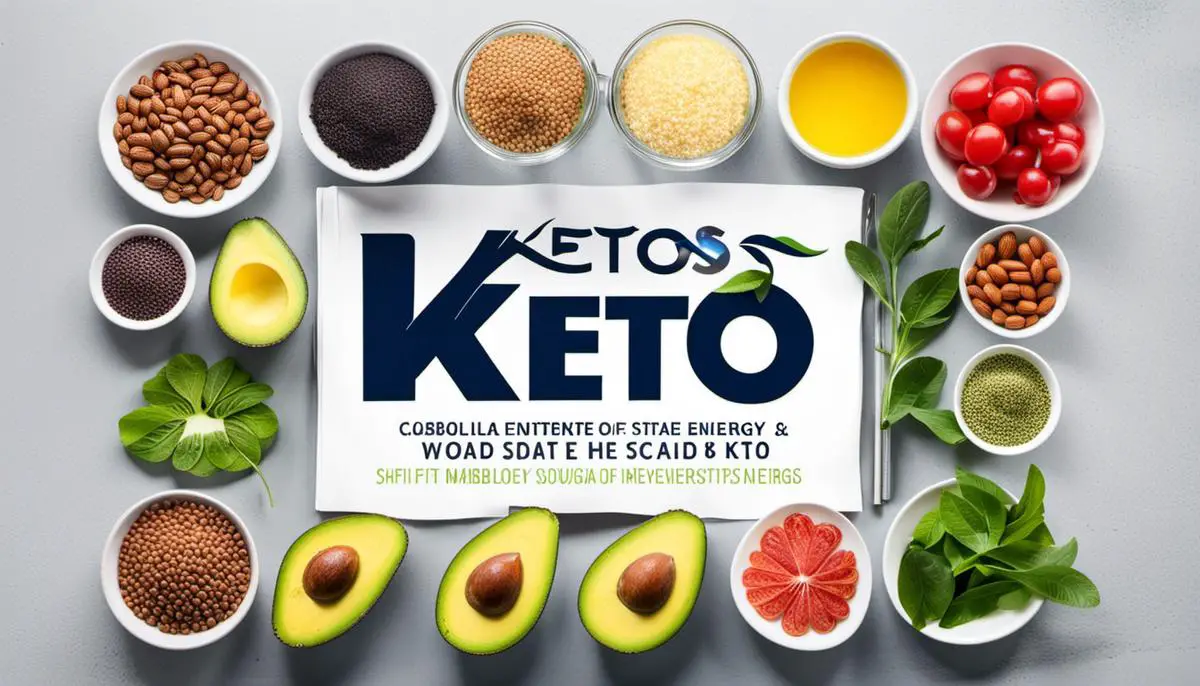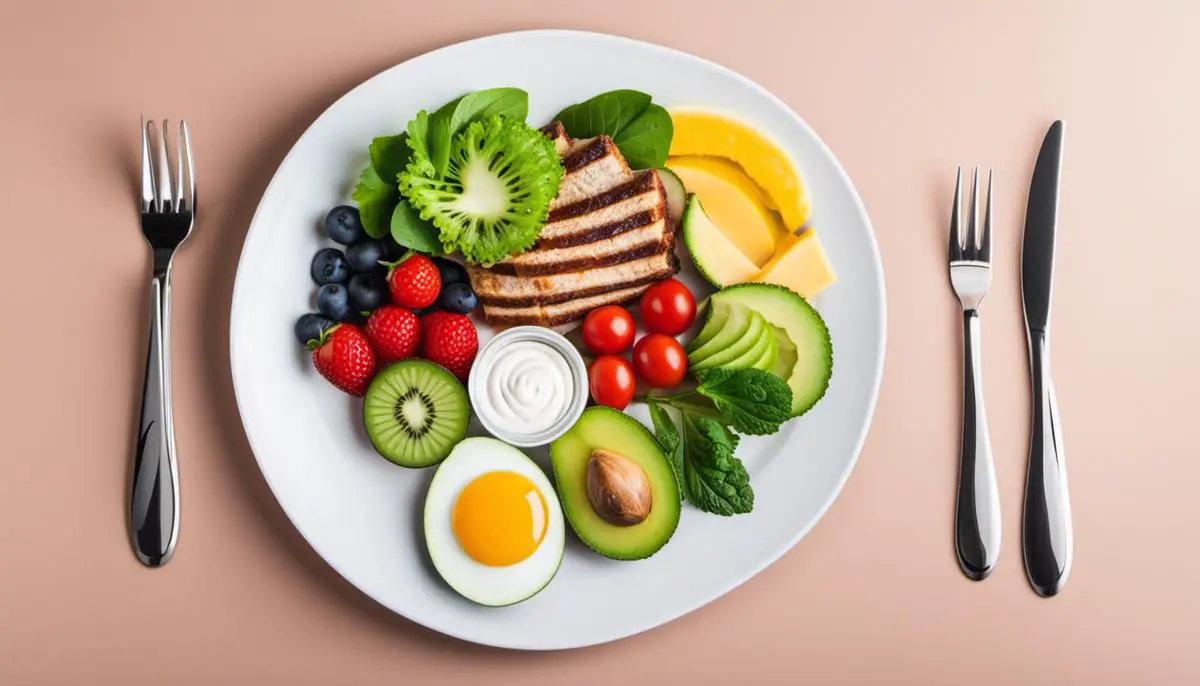In our ceaseless quest for effective weight loss and optimal health, we frequently encounter the ketogenic or Keto diet. This diet fundamentally reshuffles the primary fuel system of our bodies by encouraging fat over carbohydrate consumption. This dietary transformation instigates a process known as the ketogenic state, believed to boost weight loss, heart health, and brain function. However, like every dietary regimen, the Keto diet comes with its risk factors, including potential nutrient deficiency and mental fog.
Principles of the Keto Diet
The Science Behind the Keto Diet
The ketogenic, or “keto”, diet is based on the principle of inducing the body into a state of ketosis. Ketosis is a metabolic state where the body, instead of carbohydrates, burns fat for energy. This happens when there is limited access to glucose (blood sugar), which is the body’s preferred fuel source from the food we eat.
When you consume a meal rich in carbohydrates, your body converts those carbs into glucose. This rise in blood sugar level triggers the release of insulin, a hormone that helps glucose enter the cells to be used as energy. What’s left over is stored in the liver and muscles as glycogen or, if these reserves are full, converted into fat to be stored in the adipose tissue.
Ketogenic State: A Shift in Energy Source
The ketogenic diet drastically reduces carbohydrate intake and replaces it with fat, leading to a significant reduction of glucose and insulin in the body. This dietary restriction puts the body into a metabolic state called ketosis, forcing it to become exceptionally efficient at burning fat for energy instead of glucose.
This metabolic shift doesn’t come without its bodily changes. During the first few weeks of a ketogenic diet, the body may undergo what’s often referred to as the “keto flu” – a period filled with symptoms such as fatigue, hunger, restlessness, nausea, and irritability. This is simply the body adjusting to the significant drop in carbohydrate intake.
In addition to burning stored body fat, the liver converts fat into molecules known as ketones, which can cross the blood-brain barrier and be used as fuel by the brain. The brain is a heavy consumer of energy and can consume up to 20% of the body’s total calorie intake in a day, highlighting the need for a continuous supply of energy.
Weight Loss and the Ketogenic Diet
The ketogenic diet can be a potent tool for weight loss because it changes your body’s primary fuel source from carbohydrates to fats. Since your body starts to burn its stored fat, it can lead to weight loss. A decrease in insulin levels can also lead to a greater fat burn, as insulin is a fat-storing hormone.
Moreover, ketones suppress ghrelin (hunger hormone) and increase cholecystokinin (CCK) levels, which makes one feel full. This could also inherently reduce overall calorie intake and further promote weight loss.
However, it’s important to note that while initial weight loss may be higher with a ketogenic diet, research into long-term weight loss maintenance is limited and mixed. It’s also important to do this type of diet correctly – merely eating a diet high in fats and low in carbohydrates does not automatically lead to weight loss, especially if calorie intake exceeds expenditure.
Nutritional Ketosis vs. Ketoacidosis
It’s also essential to differentiate between nutritional ketosis, which is the goal of the ketogenic diet, and ketoacidosis, which is a potentially life-threatening condition. Nutritional ketosis is a natural metabolic state, while ketoacidosis (seen mainly in type 1 diabetics) happens when blood ketones are so high that they become harmful. In most healthy individuals, it’s almost impossible to reach a state of ketoacidosis simply by following a ketogenic diet due to the body’s feedback mechanisms.
In conclusion, the ketogenic diet, a dietary regimen high in fats yet extremely low in carbohydrates, can potentially initiate weight loss by shifting the body’s primary energy source. It leverages the body’s natural capability of burning fats to produce energy which results in fat loss, specifically for individuals who have surplus body fat. However, it’s essential to be aware of possible side effects and to undertake this diet plan under the direction of a healthcare professional.

Benefits and Risks of the Keto Diet
Digging Deeper into the Keto Diet
The ketogenic, more commonly known as the “keto” diet, is a dietary plan high in fats while deliberately low in carbs. This diet aims to drive your body into the metabolic state of ketosis, where it relies on burning fat for energy, substituting it for carbohydrates. The “keto” in ketogenic comes from ketones, the small fuel molecules produced when your body needs to burn stored fats due to a shortage of glucose.
Pros of the Keto Diet
Weight Loss
One of the main reasons people turn to the keto diet is for weight loss. By drastically reducing carb intake and replacing it with fats, your body enters a metabolic state called ketosis. In this state, your body becomes incredibly efficient at burning fat for energy. It also turns fat into ketones in the liver, which can provide energy for the brain. This may result in significant weight loss.
Improved Heart Health
Another potential benefit of the keto diet is its impact on heart health. Some studies suggest that it may help decrease levels of LDL, or “bad” cholesterol while increasing levels of HDL, or “good” cholesterol. However, these benefits depend heavily on whether one follows a ‘clean’ keto diet, full of healthful, balanced food choices, as opposed to one laden with high-fat junk foods.
Enhanced Brain Function
The ketogenic diet may have neuroprotective benefits and could help improve certain brain functions. Some research suggests that ketones produced during the diet provide a more efficient energy source than glucose, and these high energy levels might protect against brain diseases such as Alzheimer’s and Parkinson’s.
Cons of the Keto Diet
Nutrient Deficiency
One of the most significant risks associated with the keto diet is nutrient deficiency. Because the diet is so restrictive, it can be challenging to ensure you’re getting all the necessary vitamins and nutrients your body needs to function correctly. This could lead to deficiencies in vitamins A, B, C, and K, as well as certain minerals.
“Keto Flu” and Mental Fog
When you begin the keto diet, the drastic reduction in carbs can lead to a series of symptoms known as the keto flu. This can include a host of side effects such as poor energy and mental function, increased hunger, sleep issues, nausea, digestive discomfort, and decreased exercise performance. A lot of people on the diet report experiencing a mental fog and have difficulty concentrating.
Before Beginning the Keto Diet
Embarking on the keto diet, or any diet for that matter, should be a considered decision, ideally made in conjunction with a healthcare provider. This counsel becomes increasingly crucial for individuals with chronic health conditions such as diabetes, heart disease, and kidney disease. While the keto diet might have its appealing benefits, potential risks are also involved. Thus, to maintain a balance between these benefits and risks, personalized advice from a healthcare provider is highly recommended.

A Typical Keto Diet Plan
Understanding the Basics of the Keto Diet
Renowned for its perceived health benefits, such as weight loss, enhanced heart health, and lower blood sugar levels, the ketogenic – or “keto” – diet is a high-fat, low-carb regimen. It influences the body to enter a state of ketosis which allows for the burning of fat as a source of energy as opposed to carbohydrates, thus facilitating weight loss.
Understanding Macros in a Keto Diet
A standard keto diet typically includes approximately 70-75% fats, 20% protein, and 5-10% carbs. This ratio may vary slightly depending on individual health goals and nutritional needs. It’s pertinent to note that the fat consumed in a keto diet should primarily come from healthy sources such as avocados, olive oil, and nuts, not from unhealthy fats like processed foods and trans fats.
Typical Foods in a Keto Diet
A keto diet menu includes a myriad of healthy foods. Fats and oils such as butter, coconut oil, and olive oil are staples. Protein is included in the form of meats, seafood, and eggs. The diet allows non-starchy vegetables like spinach and kale, and various cheeses. Nuts, seeds, and a variety of low-carb fruits such as berries can be also eaten.
Sample Meals for a Keto Diet
For breakfast, a keto adherent might make an omelet stuffed with spinach, cheese, and avocado, prepared using coconut oil. Lunch could be a salad consisting of grilled chicken, a mix of leafy greens, topped with olive oil dressing, and a sprinkle of nuts. Dinner could be a portion of salmon grilled with a side of asparagus or zucchini sautéed in butter. Snacks might include a handful of nuts or seeds, cucumber slices with cream cheese, or a slice of cheese with some olives.
Understanding Portion Sizes on a Keto Diet
While fats should make up most of the diet, that does not mean food portions should be overly large. The goal is to feel satiated, not stuffed. Lean proteins should be approximately the size of a deck of cards, while fats like nuts should be limited to a handful. An adequate amount of low-carb vegetables can make up the bulk of the meal.
Keto Diet: A Note on Fluids and Electrolytes
Hydration is very crucial in a Keto diet as the changes can lead to fluid and electrolyte imbalance. Therefore, it is essential to drink adequate water and consume foods rich in electrolytes. Bone broth, lite-salted foods, and supplementation can help keep electrolytes in check.
Sample Meal Plans for a Keto Diet
To give a clear idea, here’s a quick one-day sample meal plan:
- Breakfast – Scrambled eggs made with butter and a side of avocados.
- Snack – A handful of almonds or celery sticks with almond butter.
- Lunch – Tuna salad made with mayonnaise, served on a bed of greens.
- Dinner – Beef stir-fry cooked in coconut oil with mixed veggies.
In case of need to snack after dinner, you may choose a hard-boiled egg, a handful of nuts, or Greek yogurt.
Embarking on the journey to a healthier lifestyle comes with a multitude of decisions, including the choice of diet. The Keto diet, having demonstrated a myriad of health benefits, is a popular choice amongst health-conscious individuals. However, transitioning to a new diet should always be done under the expert supervision of a healthcare professional or a registered dietitian who can provide you with personalized guidance based on your unique nutritional needs and health objectives.

Practical Tips to Follow a Keto Diet
Decoding the Fundamentals of the Keto Diet
Popularly known as Keto, the Ketogenic diet emphasizes a low-carb, high-fat intake, making it a powerful tool for weight loss. The key working principle of this diet is the reduction of carbohydrate consumption and its substitution with fats. The consequential decrease in your body’s carbohydrate levels pushes it into a metabolic phase referred to as ketosis. Within this phase, your body showcases heightened efficiency in burning fats to generate energy. In addition, fats are converted into ketones within the liver, thus creating an alternative energy source for the brain.
Preparing Your Meal Plan
A crucial part of any successful diet is planning. The first step to following a Keto diet is to prepare your meal plan. When composing your meals, remember that an ideal Keto diet should consist of 70-75% fat, 20% protein, and only 5-10% carbs. Include a variety of foods like lean meats, fatty fish, eggs, butter, unprocessed cheese, nuts and seeds, healthy oils, avocados, and low-carb veggies.
Understanding Potential Side-Effects
Just like any diet, the Keto diet also has potential side effects, often referred to as the ”Keto Flu.” Symptoms usually appear within the first few days and can include poor energy, mental function, increased hunger, sleep issues, nausea, and decreased exercise performance. These symptoms are temporary and usually disperse after a few days as your body adjusts to the new diet.
Drinking Plenty of Water
The importance of hydration cannot be underestimated while following a Keto diet. Because the diet acts as a natural diuretic, you’ll find yourself urinating more often. This increased urination can lead to dehydration, decreased metabolism, and feelings of fatigue. Make sure to keep your water bottle handy and aim for at least 64 ounces of water consumption each day.
Incorporating Exercise
Regular exercise is a fundamental part of maintaining good health, regardless of the diet you are following. When it comes to Keto, exercise can help to increase ketone levels and aid in transitioning into ketosis more quickly. However, be aware that your energy levels can dip during the initial stages of the diet. Start with light and moderate workouts and as your body adjusts, reintroduce intense workouts back into your routine.
Practicing Intermittent Fasting
Intermittent fasting combined with a Keto diet can be another effective way to enter ketosis. This practice involves eating all meals within a specific window of time. The most common form, the 16/8 protocol, typically involves consuming all meals within an 8-hour window and fasting for the remaining 16 hours.
Balancing Macronutrients
The key to a healthy and effective Keto diet is balancing your macronutrient intake. While maintaining a high-fat intake is important, feeding your body with quality proteins and low-carb veggies is just as crucial. Nutrient-dense foods like spinach, broccoli, almonds, and salmon are excellent choices.
Taking Supplements
To make sure your body gets all the essential nutrients it needs, consider taking supplements. Magnesium, MCT oils, Exogenous ketones, and Omega-3 fatty acids are commonly recommended. However, check with your doctor before starting any supplement regime to make sure it’s safe for you.
Visiting Your Doctor Regularly
Regular check-ups are essential when you’re following a diet like Keto. Your doctor can monitor your progress and perform blood tests to keep an eye on your cholesterol and triglyceride levels. This ensures that the diet is positively impacting your health, rather than causing harm.
When thinking about adopting a new diet, it’s crucial to consider it as part of a balanced and sustainable lifestyle, not just a quick solution to shed a few pounds. Any significant shift in our eating habits, such as starting the Keto diet, can require personal adaptations and may not suit everybody. So, before navigating such changes, it’s always advisable to consult a healthcare provider.

Who Should Consider the Keto Diet
Who Could Benefit from the Keto Diet
The ketogenic, also known as the “keto” diet, is a regimen high in fats but low in carbs. Besides promoting weight loss, it can also aid in improving several health conditions. Certain individuals, such as those dealing with overweight issues, type 2 diabetes, and specific neurological issues, might particularly benefit from this diet plan.
Overweight and Obese People
Overweight or obese individuals may experience significant benefits with a keto diet. The concept behind the diet is to induce the body into a metabolic state known as ketosis, where it burns fat for fuel instead of carbohydrates. Through this process, adherents can potentially lose weight more rapidly compared to traditional low-fat diets.
People with Type 2 Diabetes
People with type 2 diabetes stand to benefit from following a keto diet due to its potential to promote weight loss and improve glycemic control. A review published in the European Journal of Clinical Nutrition highlighted that a low-carbohydrate, ketogenic diet could substantially reduce the blood sugar levels of individuals with type 2 diabetes.
Individuals with Neurological Diseases
Interestingly, the ketogenic diet was originally developed in the 1920s as a treatment for epilepsy in children. Studies have shown it to be a highly effective treatment, particularly for cases of drug-resistant epilepsy. For neurological disorders, the diet may help reduce symptoms and slow progression. However, more research is needed in this domain to more clearly define benefits and potential risks.
People Desiring Enhanced Athletic Performance
Some studies suggest that the ketogenic diet may enhance endurance in athletes by improving the body’s capacity to utilize fat as a fuel source. The human body has a much greater reserve of fat than of glycogen, thus shifting to fat as a primary fuel might allow extended exertion.
However, while the diet has potential benefits, it is not appropriate or safe for everyone.
People with Certain Health Conditions
People with pancreatic disease, liver conditions, thyroid problems, eating disorders, gallbladder disease, or those who have had their gallbladder removed should not follow the ketogenic diet. Due to the limited uptake of carbohydrates, individuals with these ailments may experience additional health complications.
Individuals in Need of a Balanced Diet
The ketogenic diet restricts various fruits, vegetables, and grains, which could lead to deficiencies in certain nutrients, such as vitamins A, D, E, K, and B vitamins, if not properly managed. These dietary restrictions could make it challenging for some individuals to adhere to the keto diet long-term.
Before starting any diet, including the ketogenic diet, it is essential to consult with a healthcare provider or a registered dietitian to ensure it is a safe and appropriate choice given one’s health status and nutritional needs.

Overall, individuals considering incorporating the Keto diet into their lifestyle should execute this transition thoughtfully and with prior medical consultation, particularly for those with specific health conditions. Everyone’s body and health requirements are as unique as their fingerprints, therefore there isn’t a universally ideal diet, and the Keto diet is no exception. It can yield remarkable results for some, yet may not be suitable or effective for everyone. Educating oneself about the diet’s principles, benefits, risks, meal plans, and practical implementation tips is the initial step in making an informed decision about whether the Keto diet is the right path for you.

